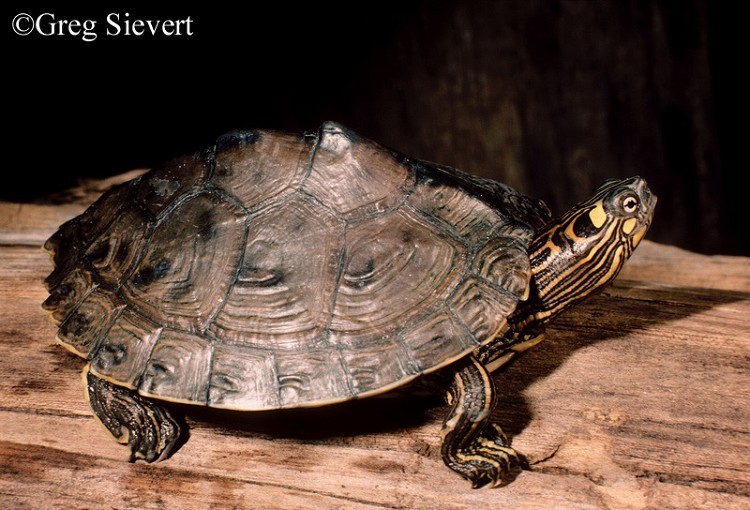Ouachita Map Turtle, Graptemys ouachitensis
Found in the Mississippi, Tennessee, and Cumberland Rivers. One subspecies, Ouachita Map Turtle (G. o. ouachitensis), occurs in TN; formerly classified as a subspecies of the False Map Turtle (G. pseudogeographica pseudogeographica).
Description: A medium-sized turtle (males 3.5 to 6.5 inches; females 5.0 to 10.25 inches in length) with a distinct large, yellowish rectangular or oval patch behind each eye. Carapace (upper shell) is olive-green to brown with dark smudges on the scutes (plates); covered with intricate yellow lines, resembling roads or waterways on a map.
Along the backbone of the shell is a blunt keel and the back end of the shell is serrated. Head, neck, and limbs are dark green with thin yellow lines. Yellow spots also occur below each eye and below that on the lower jaw. Plastron is dull yellow with grayish color along the margins of the scutes. Eyes are bright yellow with a black horizontal slit.
Similar Species: False Map Turtle has a backward, yellow “L” mark behind eye with narrow, yellow neck stripes touching the edge of each eye. Mississippi Map Turtle has yellow crescent behind eye and neck stripes do not touch edge of eye. Northern Map Turtle has smaller and less rectangular shaped spot behind eye, and less prominent knobs on keel. Painted Turtle has unkeeled shells. Eastern River Cooter has dark, donut-shaped markings under the marginal plates. Pond Slider has larger red (or sometimes yellow) ear patch and leg stripes.
Habitat: Prefers large rivers and lakes with aquatic vegetation and plenty of basking sites.
Diet: Males are mostly carnivorous while females are more herbivorous.
Breeding information: Courtship and mating occur in the water during the spring. Females lay 6-15 eggs during the summer, usually on sandbars or sandy soil. Hatchlings emerge in later summer or early fall, or they overwinter in the nest.
Status in Tennessee: Fairly common in the Mississippi and Tennessee Rivers.
Fun Facts:
- The name Ouachita comes from a Native American tribe, which used to live in northeastern Louisiana.
Best places to see in Tennessee: Main channels and tributaries of the Mississippi and Tennessee Rivers.
Conant, R. and Collins, J. 1998. Peterson Field Guides: Reptiles and Amphibians (Eastern/Central North America). Houghton Mifflin Company, New York. 616pp.
Johnson, T.R. 2006. The Amphibians and Reptiles of Missouri. The Missouri Department of Conservation, Jefferson City, MO.
